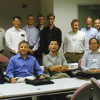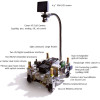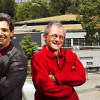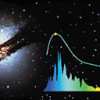NERSC Center News
Lawrence Berkeley National Lab Leads International Team to Win High-Performance Computing Bandwidth Challenge
An international team led by scientists at the U.S. Department of Energy's Lawrence Berkeley National Laboratory achieved their third consecutive victory in the High-Performance Bandwidth Challenge at the SC2002 Conference on high-performance networking and computing. Read More »
Berkeley Lab to Share Computing, Networking Expertise in SC2002 Technical Program and Exhibition
Lawrence Berkeley National Laboratory, a leader in advancing scientific computing for the U.S. Department of Energy, will share its expertise with the high-performance computing and networking community at the SC2002 conference to be held Nov. 16-22 in Baltimore. Read More »
NERSC to Offer 10 Teraflop/s System by Early 2003
The U.S. Department of Energy's National Energy Research Scientific Computing (NERSC) Center has signed a contract with IBM to double the size of NERSC's 3,328-processor RS/6000 SP supercomputer, creating a machine with a peak speed of 10 teraflop/s. Read More »
Creating Science-Driven Computer Architecture: The "Blue Planet" Proposal
In recent years scientific computing in America has been handicapped by its dependence on hardware that is designed and optimized for commercial applications. Lawrence Berkeley and Argonne national laboratories, in close collaboration with IBM, have responded to the challenge with a proposal for a new program to bring into existence a new class of computational capability in the United States that is optimal for science. Read More »
Lawrence Berkeley National Laboratory Team Achieves 10.6 Gigabits/Second Data Throughput in 10-Gigabit Ethernet Test
Although there has been a lot of discussion recently about 10-Gigabit Ethernet capability, actually achieving that level of performance in the real world has been difficult. Until now. a team from Lawrence Berkeley National Laboratory with Force10 Networks (switches), SysKonnect (network interfaces), FineTec Computers (clusters), Quartet Network Storage (on-line storage) and Ixia (line rate monitors) assemble a demonstration system that runs a true scientific application to produce data on one 11-processor cluster, then sends the resulting data across a 10-Gigabit Ethernet connection to another cluster, where it is rendered for visualization. Read More »
Berkeley Lab's RAGE Telepresence Robot Captures R&D100 Award
Berkeley Lab's Remote Access Grid Explorer (RAGE), a remote-controlled robot providing two-way interaction via the global Access Grid, has been named a winner of the 2002 R&D100 Award presented by R&D Magazine. Read More »
Registration Open for September 4-7 Workshop on the DOE Advanced Computational Software Collection
Applications are now being accepted to attend a workshop on "Robust and High Performance Tools for Scientific Computing" sponsored by the U.S. Department of Energy's National Energy Research Scientific Computing Center (NERSC). Read More »
Andreas Adelmann Is NERSC's First Alvarez Fellow in Computational Science
Selected as the first recipient of NERSC's Luis Alavarez Postdoctoral Fellowship in Computational Science, Adelmann, his wife and three children recently moved into a home in North Berkeley. Read More »
IBM and Department of Energy Supercomputing Center to Make DOE Grid Computing a Reality
IBM and the U.S. Department of Energy's (DOE) National Energy Research Scientific Computing Center (NERSC) today announced a collaboration to begin deploying the first systems on a nationwide computing Grid, which will empower researchers to tackle scientific challenges beyond the capability of existing computers. Read More »
NERSC's Peter Nugent Named to Hubble Space Telescope Users Committee
Peter Nugent, an astrophysicist in NERSC's Scientific Computing Group who made news last year as co-discoverer of the oldest supernova ever found, has been asked to join the Hubble Space Telescope Users Committee. The committee is an international panel of 12 scientists who serve for three years. Read More »











